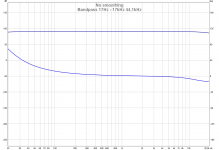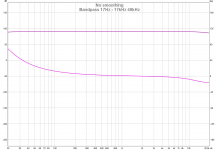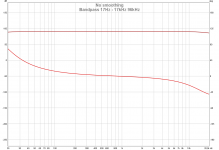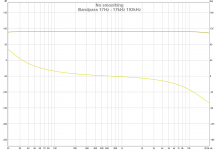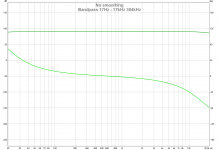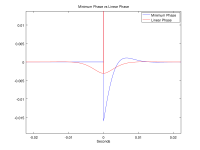.....The tweeter being early isn't even seen in a group delay plot, the low end is more obvious but smaller than I had expected it to be in sound.....
Guess its the lack of headroom at HF bandwidth for our measurement systems that tweeter is presented as linear as it is up HF area. Think if our microphones had higher reach than they have and we set up sample rate under measurements to be 96kHz or higher then phase will show more true real world early phase in HF area of audio band.
As example below where a 17Hz - 17kHz system band pass IR wav-file is created in Rephase at 44,1/48/96/192/384kHz, frq response is exactly same in 5x plots but the better the HF bandwidth the more true HF phase is to theory and real world.
Attachments
Guess its the lack of headroom at HF bandwidth for our measurement systems that tweeter is presented as linear as it is up HF area. Think if our microphones had higher reach than they have and we set up sample rate under measurements to be 96kHz or higher then phase will show more true real world early phase in HF area of audio band.
As example below where a 17Hz - 17kHz system band pass IR wav-file is created in Rephase at 44,1/48/96/192/384kHz, frq response is exactly same in 5x plots but the better the HF bandwidth the more true HF phase is to theory and real world.
Yes, it's the very short time needed at HF that's not showing in group delay.
So Higher sample rate has earlier tweeter response? Is that what this is showing? Is the band pass exactly the same in values? Why would that be.
The time it takes to play a 17 KHz tone isn't different between 44.100 and 384.000. Thanks for that plot, why is this happening? I don't get it.
That sentence you quoted should have said: smaller than I had expected it to be, judging from the difference in sound.
I got in on the audibility of phase discussion. I have no crossovers in my setup.
So I could post impulse plots but they don't apply to the original question in this thread.
My results were posted in my thread: http://www.diyaudio.com/forums/full...o-towers-25-driver-full-range-line-array.html along with many impulse plots and STEP responses. ray wanted to know what I was talking about, mentioning minimum phase vs linear phase. That was the intent of those plots. 🙂
That's an awful long thread to read looking for a particular plot or two.
I've created an idealized comparison between a minimum phase system with low end roll off, and a linear phase system with the same roll off. The linear phase version starts responding before the main impulse, while the minimum phase version does not. The minimum phase version deviates from 0 about half as long as the linear phase version, although it does deviate farther.
Should we really be surprised that someone would prefer the minimum phase version compared to the linear phase version? I wouldn't be.
Would this preference be universal? I'm not sure.
We could create .wav files for people to compare.
Note: Both impulses spike up to just shy of 1, but the peak isn't shown in order to see more detail in the area of interest. Time extent and ripple height depend on low end extension and system Q.
Attachments
Last edited:
.....Thanks for that plot, why is this happening? I don't get it.....
Showed it because one day i got to think about when running IRR filters in free Texas Instrument suite TINA that a BW2 17kHz roll off will truly be in minus 90º status at 17kHz but when i measure my own 10F at 44,1kHz it is nearly flat phase up to 20kHz as in the low sample rate Rephase example. Think its because TINA suite has infinite bandwidth and therefor able to show as things real is, but a measure sweep at 44,1kHz will cap HF bandwidth with a IRR filter at 22,05kHz so can't show anything up there and at same our microphones is also totally blind above audio band. Further also think mystery about microphones why calibration file is capped at 20kHz, can understand that for cheap ones with cheap factory calibration files but why is it still capped at 20kHz when calibration is from a pro certified company that have really high end equipment as reference, and by that can plot microphone under test above 20kHz even it has bad performance there.
Showed the 5x plots with different sample rate from Rephase created IR wave files because same happen for HF phase real world if measurement suite is set at 44,1/48/96 or 192kHz sample rate.
Last edited:
I know the answer if no one has mentioned it yet. There are various reasons, which seem to have been covered, for reversing the tweeter or midrange polarity. We all know how the bass is cancelled out when you accidentally reverse the phase of one of your speakers. The low frequencies are the least affected by phase shifting in the crossover but the most noticeable when 2 drivers are 180 degrees out. The reason the woofer phase is not reversed is so that the woofers of any speakers connected to the system will be in phase, regardless of brand or model.
Unless you happen to have older JBL or Tannoy speakers, as was mentioned in post #11.The reason the woofer phase is not reversed is so that the woofers of any speakers connected to the system will be in phase, regardless of brand or model.
Woofer "phase" is dependent on frequency and cabinet design, though their polarity is easy to test with a visible cone.
The relatively recent convention of positive voltage moving the cone away from the magnet structure is simply a convention, like reading from left to right, but just as there are many languages that differ, there are still lots of speakers (and microphones) with opposite polarity to the present convention.
Since growing up with both conventions, and having a factory recone come back reversed, I always check polarity before and after wiring a speaker, using a battery.
Fortunately, the polarity convention for batteries has been consistent for as long as I've been testing speakers, though older cars used a positive ground, opposite from today's negative ground...
Art
Last edited:
- Status
- Not open for further replies.
